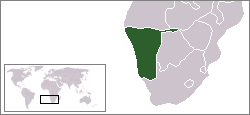Namibia
Namibia is in Southern Africa, bordering South Africa, Botswana, Angola, Zambia and the Atlantic Ocean. Namibia boasts remarkable natural attractions such as the Namib Desert, the Fish River Canyon Park, Etosha National Park and the Kalahari desert. Thanks to both a wealth of indigenous cultures and a tumultuous colonial history, its people speak nine different languages, including some of the Khoisan languages which include the 'clicks' that present an enigma to most native English speakers. It is also one of the few places in Africa where German, although not official, remains a commonly spoken language, while Afrikaans, shared with its southern neighbour, is also prevalent.
Blending German, Boer and indigenous heritage in its surprisingly European-looking cities, unique desert landscapes, rich wildlife and a relatively high standard of living, resulting in part from abundant natural resources (for example, Namibia produces the world's highest-quality gem diamonds), Namibia is today a peaceful country, welcoming to visitors and offering unforgettable experiences.
Regions
| Caprivi The panhandle in the northeast of the country. With two major rivers, the Caprivi is one of the few areas of Namibia that has water. Caprivi was created in an attempt to give Germany access to the Indian Ocean via the Zambezi River, though this proved impossible because of Victoria Falls. |
| Kavango |
| Four-O region |
| Kunene |
| Otjozondjupa |
| Omaheke |
| Erongo |
| Khomas |
| Hardap |
| ǁKaras |
Cities
- 🌍 Windhoek—Namibia's capital and largest city
- 🌍 Gobabis, capital of Omaheke
- 🌍 Katima Mulilo, capital of the Zambezi region in the Caprivi Strip
- 🌍 Keetmanshoop, capital of ǁKaras
- 🌍 Lüderitz—colonial-era German coastal town, with the ghost town of Kolmanskop nearby
- 🌍 Mariental, the capital of Hardap
- 🌍 Opuwo—capital of Kunene Region and an ideal starting point for stocking up before venturing further into Kaokoland
- 🌍 Rundu
- 🌍 Swakopmund, capital of Erongo and a mecca for Namibians on holiday
Other destinations
- 🌍 Brandberg Mountains — The highest mountain in Namibia at 2 573 m.
- 🌍 Etosha National Park — Abundant wildlife in the "big white place"
- 🌍 Fish River Canyon Park — The second largest canyon in the world.
- 🌍 Kaokoland — home to the Himba tribe, desert elephants, desert lions, Epupa Waterfalls and many more attractions in this northwestern corner of the country.
- 🌍 Skeleton Coast — The northern coastal part of the Namib desert, named for the dozens of ships that were beached in the thick fog that is frequent where the desert meets the Atlantic.
- 🌍 Sossusvlei — The most popular entry point for people wanting to visit the Namib desert.
- 🌍 Spitzkoppe — the Matterhorn of Namibia.
- 🌍 Waterberg Plateau Park — Another good place to watch wildlife.
Understand
In a nutshell, Namibia was inhabited by San people until about 1,000 years ago. If you have the rare opportunity to talk to a San (most do not speak English), do not call them Bushmen, that's considered derogatory. Due to the Bantu migration, Ovambo people and Ovaherero people moved into northern and central Namibia. In the South the Damara people estableshed themselves; it is unclear where they came from. About 200 years ago the Oorlam people moved in from the South. Then the Oorlam and the Herero clashed.
.jpg)
Namibia was colonized by Germany in the late 19th century. Colonial control was established by private interests before the German Reich itself got involved as Bismarck was rather skeptical of colonial endeavors. German business and colonial interests, among them Adolf Lüderitz, tried to co-opt local rulers into their schemes and to that end signed treaties of varying honesty and even-handedness. One treaty famously mentioned a strip of land from the coast several "miles" inland to be handed over to the colonizers. What the treaty failed to mention was that the British miles of roughly 1.6 km wasn't what the Germans meant - they insisted upon much larger "Prussian miles" that were obscure even then and entirely unknown to the locals.
Needless to say conflict broke out, but the colonizers had the better weapons and ultimately also backing from Berlin so the locals stood no chance. By 1884 "Deutsch Südwestafrika" had officially become a colony and unlike Germany's other colonies, it did attract significant settlement from the mother country, soon leading to serious debates in the Reichstag about the "problem" of "mixed" descendants of settlers and locals. Another problem were local uprisings and when the Herero rose up in 1904 the Germans under general Lothar von Trotha responded with an amount of genocidal cruelty that shocked even contemporary advocates of colonialism. Von Trotha issued an order to shoot down unarmed civilians including women and children and had them driven into the desert. Low estimates put the death toll at 40,000 but numbers as high as 70,000 have been put forth for this first genocide perpetrated by Germany. Both descendants of von Trotha and the German government have since asked for forgiveness but no formal restitution was ever paid. At the start of World War I, only 30 years after they arrived, much of Namibia (then called South West Africa) was in German possession.
During World War I Africa also became a front but by 1915 Namibia had fallen to the Entente. It was administered by South Africa under a League of Nations mandate after World War I, and as if it were a province of South Africa after World War II. The South-West African People's Organization (SWAPO) launched a guerrilla war for independence in 1966 and gained independence in 1990. Namibia is in many ways quite similar to South Africa. Since it was ruled under the apartheid system, Namibia also has many of the problems resulting from that system.
Since Namibia is similar to South Africa, if you're used to travelling in one country, travelling in the other country is quite easy. However, there are some subtle differences. For example, in South Africa a non-white person may choose to speak English rather than Afrikaans (as a political choice) whereas among Namibia's mixed-race population (who call themselves 'colored' in Namibia and South Africa) Afrikaans is a proud part of their culture, and many people still speak German. Overlooking these differences isn't going to cause offense, but they're handy to know.
The public holidays in Namibia are:
- 1 January. New Year's Day
- 21 March. Independence Day
- Easter weekend. ("Good Friday", "Easter Saturday", "Easter Sunday" and "Easter Monday"): a four day long weekend in March or April set according to the Western Christian dates.
- 1 May. Workers Day
- 4 May. Cassinga Day
- 25 May. Africa Day
- 26 August. Heroes' Day
- 10 December. Human Rights Day
- 25 December. Christmas Day
- 26 December. Day of Goodwill (Family Day)
Get in
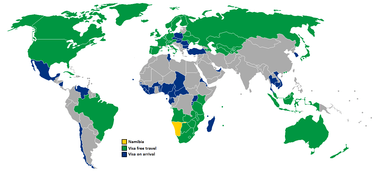
Visas
Tourists may enter Namibia for up to 90 days.
Foreign nationals from the following countries/territories will get a visa on arrival without prior application: Angola, Australia, Austria, Belgium, Botswana, Brazil, Canada, Countries in the Commonwealth of Independent States, Cuba, Denmark, Eswatini, Finland, France, Germany, Hong Kong SAR, Iceland, Ireland, Italy, Japan, Kenya, Lesotho, Liechtenstein, Luxembourg, Macao, Malaysia, Malawi, Mauritius, Mozambique, New Zealand, Netherlands, Norway, Portugal, Russia, Singapore, South Africa, Spain, Sweden, Switzerland, Tanzania, United Kingdom, United States of America, Zambia and Zimbabwe.
Citizens not from the above countries need to apply for a visa from the Namibian consulate in their country of origin or the Ministry of Home Affairs, Private Bag 13200, Windhoek, ☎ +264 61 292-9111, fax: +264 61 22-3817.
To apply for a visa from a Namibian embassy or consulate, you will need a visa application form (this is one from the Namibian High Comission in London), a document confirming your address in Namibia (such as a hotel booking), a passport with three blank pages and a colour passport photo.
If you require a visa to enter Namibia, you might be able to apply for one at a British embassy, high commission, or consulate in the country where you legally reside if there is no Namibian diplomatic post. See the UK government website about applying for Commonwealth visas. British diplomatic posts charge £50 to process a Namibian visa application and an extra £70 if the authorities in Namibia require the visa application to be referred to them. The authorities in Namibia can also decide to charge an additional fee if they correspond with you directly.
All visitors require a passport valid for at least 6 months after date of entry into Namibia.
You need a return or onward air or bus ticket when you fly to Namibia; if you don't have one the airline will not take you there (Air Namibia will inform you about this at check in time! you can book a Intercape bus ticket online. Intercape have buses from Namibia to South Africa and Zambia.
They will not let you in if you don't have an address where you are going, so be sure to have one.
Always verify the dates stamped into your passport, because there have been cases where corrupt officers stamp wrong dates to fine people for overstaying when they leave, and these fines are huge.
By plane

Hosea Kutako International Airport, located 45 minutes east of Windhoek, is the main entry point for air traffic. Air Namibia operates flights from Frankfurt, Cape Town, Johannesburg, Victoria Falls, Maun, Harare, Lusaka, Luanda. South African Airways British Airways, Airlink, South African Express and no-frills Kulula.com operate flights to and from South Africa. TAAG Angola Airlines operates flights to Luanda.
By car
There are 9 commonly used border posts with neighbouring countries:
Angola
- Oshikango (Santa Clara), ☎ +264 65 26-4615, fax: +264 65 26-4616.
- Ruacana, ☎ +264 65 27-0290, fax: +264 65 27-0010.
Botswana
- Buitepos (Mamuno), ☎ +264 62 56-0404, fax: +264 62 56-0418. On the Trans-Kalahari-Highway, connecting the B6 and A2 between Gobabis and Ghanzi
- Mhembo (Shakawe), ☎ +264 66 25-9900, fax: +264 66 25-9902.
South Africa
- Araimsvlei (Naroegas), ☎ +264 63 28-0057, fax: +264 63 28-0058. Connecting the B3 and N14 between Karasburg and Upington
- Verloorsdrift (Onseepkaans), ☎ +264 63 26-9134. Connecting the C10 and R358 between Karasburg and Pofadder
- Noordoewer (Vioolsdrift), ☎ +264 63 29-7122, fax: +264 63 29-7021. Connecting the B1 and N7 between Keetmanshoop and Springbok
- Oranjemund (Alexander Bay), ☎ +264 63 23-2756, fax: +264 63 23-3483.
Zambia
- Wenela (Sesheke), ☎ +264 66 25-3430, fax: +264 66 25-2293.
By international bus
The most convenient international bus services into Namibia run from Cape Town, Victoria Falls, Johannesburg and Gaborone.
- Intercape Mainliner have buses from Windhoek to Victoria Falls, Capetown, and the Angola border.
- Monnakgotla travel have a bus two times a week from Windhoek Namibia to Gaborone Botswana.
- Insight Luxury Coaches have a bus two times a week from Windhoek to Livingstone Zambia. fares are from N$450. which is less than the fare with Intercape
By train
The regular overnight train from Upington in South Africa to Windhoek, operated by TransNamib, has been discontinued. It is no longer possible to get into or out of Namibia by train.
Get around
Legal issues
Travellers are expected to produce an ID of any sort if Police, health inspectors or customs officials stop them. If it isn't expired, any passport, ID or drivers license will do. Namibia is very concerned about child trafficking. When travelling with children you need to carry their full birth certificate to prove they are yours. When only one parent is travelling, a consent letter from the other parent (alternatively a death certificate) is required, even if you are married or have sole custody.
There is a veterinary demarkation between northern Namibia and the rest of the country, at approximately the latitude of Etosha. Check Wikipedia for details. No meat may be taken from north of the line southwards. You will nevertheless be checked both ways, nobody knows why.
By plane
- Westair Aviation (ex Westwing), ☎ +264 61 372 300, fax: +264 61 232 402, e-mail: info@westair.com.na. Offers both scheduled and charter flights throughout the country.
By train
The national railway company of Namibia, TransNamib, operates trains (and buses) to destinations all over Namibia via their StarLine passenger service. Some routes available are
- Windhoek-Otjiwarongo-Tsumeb
- Windhoek-Gobabis
- Windhoek-Swakopmund-Walvis Bay
- Windhoek-Keetmanshoop (formerly also to Upington in South Africa but not any more)
- Walvis Bay-Swakopmund-Tsumeb
The StarLine scheduled service conveys passengers via special coaches hooked on the back of freight trains. These passenger coaches offer comfortable airline-style seating with air-conditioning and (sometimes) video entertainment. Vending machines provide refreshments on long journeys. StarLine, ☎ +264 61 298-2032, fax: +264 61 298-2495, e-mail: paxservices@transNamib.com.na.
Other rail services operating in the country are:
- Desert Express, ☎ +264 61 298-2600, fax: +264 61 298-2601, e-mail: dx@transNamib.com.na. The Desert Express is a luxury tourist train that traverses Namibia regularly, taking tourists to such destinations as Walvis Bay, Swakopmund and Etosha National Park. Buses are used to transport visitors from train stations to the various sights.
By car
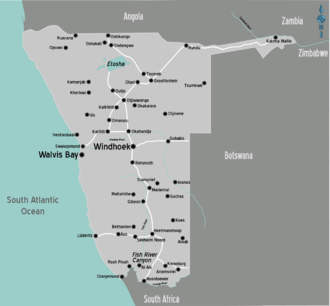
Despite the vast distances in Namibia, most people get around by land, and not air. If renting a car, plan to have plenty of cash on hand to fill the tank with gasoline. Gas stations typically do not accept any form of payment except cash. A small tip for the attendant pumping your gasoline of N$3-5 is quite common. If you are on the back roads of Namibia, it's always wise to stop and top-off your tank when you see a service station.
Namibia's roads are very good, with primary routes paved, and secondary routes of well-graded gravel. An all-wheel drive vehicle is not necessary except on tertiary roads and the Skeleton Coast. Driving at night is very dangerous because there is a lot of wildlife on the roads. Traffic drives on the left. Namibian roads eat tires and chip windscreens. Always check your spare and inspect your tires often. If someone overtakes you on a gravel road, drive as far left as possible to avoid being hit by flying stones.
Namibia has some of the worst road accident statistics per head of population. The speed limit on tarred roads is 120 km/h but few drivers adhere to it. There is an unbelievable amount of head-on collisions due to overtaking at unsuitable spots. Self-driving tourists "score" mostly in the 'no other party involved' accident category, losing control of their cars for no apparent reason but speed. Driving on dirt roads is unlike any other driving experience that Europeans or North Americans can gain at home, and the 100 km/h speed limit does not mean you should, or even can, drive safely at that speed. This farmer overtaking you at breakneck speed knows every rock and every puddle on this road, has a better suitable car, and likely a few hundred thousand kilometers of experience on her belt.
Namibians often estimate the time to drive between places according to their own vast experience driving quickly on dirt (untarred) roads. Add a third and you will arrive alive with kidneys intact!
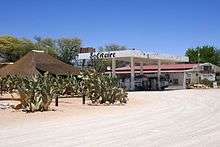
Before you reserve a car let the rental company send you a copy of its rental agreement. Most of them have many (and sometimes absolutely ridiculous) restrictions. Take your time to compare them according to your needs. Small damage to tires, windscreens, and the vehicle front is almost unavoidable on gravel roads. The rental company will charge you for that, or will try to sell expensive add-ons to the contract. When picking up your car, check that the spare wheel is of the same type as the regular wheels, and that the tools for changing it are complete.
- Drive South Africa (Car and 4X4 Hire), ☎ +27 21 423 6957, e-mail: info@drivesouthafrica.co.za. Rental branches' pick-up and drop-off locations are offered in eight locations throughout the country, including Namibia’s airports and major cities.
- Europcar Car Hire (Car Hire), ☎ +264 61-227103, e-mail: info@europcar.co.za. Car rentals in Namibia.
- Kalahari Car Hire (Car hire Windhoek), 109 Daan Bekker Street, Windhoek, ☎ +264 61 252 690, e-mail: iti07553@mweb.com.na.
- CABS Car Hire Namibia (Car hire Windhoek), 282 Independence Ave, Windhoek, ☎ +264 61 305 912, e-mail: info@cabs.com.na.
- Windhoek Car Hire (Windhoek Car hire), 124 Andimba Toivo Ya Toivo Street, Windhoek, ☎ +264 61 306 553, e-mail: info@windhoekcarhire.com.
- Thrifty Car Rental, ☎ +264 61 220 738. Offers 24 hour car rental service for a scenic drive through Namibia
- AAA Car Hire, ☎ +264 811 246 286, fax: +264 61 244558, e-mail: info@namibweb.com. Sedan, 4WD and bus rentals in Namibia.
By taxi
There are two types of taxi services in Namibia: shared taxis and dedicated taxis, often called "radio taxis" or "call-a cab". The shared taxis have a license restricting their movement, either to within a town, or between a set of towns. Taxi fares of shared taxis are regulated by government and cannot be bargained on. However, taxi drivers might nevertheless overcharge tourists who do not know what the standard fares are. Radio taxis have no such restriction but charge between 5 and 10 times for the same ride.
Shared taxis are seldom roadworthy - any car in Namibia must pass the roadworthy test only upon change of ownership. It is not uncommon to see bonnets tied by steel wire, emergency spare tyres, broken screens, and the like. Drivers habitually jump red lights (in Namibia: "robots") and stop signs and will let passengers embark wherever they find them, including on highways and in the middle of an intersection. Be considerate to other drivers by not waving at a taxi where it is not safe to stop.
It is quite easy to get around towns by long-distance shared taxis. They are fast, sometimes scarily so, and they are cheap. Just ask around to find out where the taxi rank is (sometimes there are several taxi ranks, each one with departures to different areas of the country). None of these will take you to tourist destinations, though, as those are almost always away from the larger settlements. For taxis that operate within a town it is expected that you, instead of waving at them, point into the direction you wish to travel.
A lot of companies offer affordable shuttle services between most towns like Windhoek, Swakopmund, Walvis Bay, Tsumeb, Otjiwarongo etc. These services are perfectly safe but more expensive than taxis.
By bus
- TransNamib. Operates air-conditioned buses (and trains) to destinations all over Namibia via their StarLine service.
By tour
Several tour companies operate in Namibia. Each is unique in services offered but most operate with safety in mind.
- Okutembuka Safaris. A company that specialises in private guided day tours, multi-day tours or self-drive safaris.
Hitchhiking
Hitchhiking is uncommon in Namibia. While it is possible to get a hike from one town to another, the typical "See" and "Do" activities are out in the countryside. For whatever reason, most Namibians have never visited any of their tourism establishments, never seen a wild animal larger than a baboon, and never stayed in tourist accommodation. Only other tourists will go there, and they often have no space in their cars or no willingness to give you a lift. Even worse than to go from a town to a landmark, is going from one landmark to the next. Namibia as a whole is very much off the beaten track, very sparsely populated, and has very little traffic overall. You might stand days at Sossusvlei hitchhiking to the Naukluft. Let's hope you brought water and food. If you finally get a hike, the driver will typically ask for a contribution to his petrol expenses, so it is not even for free.
Talk
Major Indigenous languages include Oshiwambo, Otjiherero, Damara/Nama, various San languages, Rukwangali, and Silozi.
English is the official language and is widely spoken. However, the majority of older Namibians (those educated before independence) speak English only as a third language; therefore, the standard is fairly poor. English is more widely spoken in the north, as it was adopted as a medium of instruction earlier than in the south. Older Namibians in the South are more likely to speak Afrikaans or German.
Afrikaans is spoken by many and is the first language of the Coloureds as well as the Afrikaners. English is spoken as a first language by the remaining English families, and German is spoken by the Namibians of German descent, who tend to be in Windhoek, Swakopmund and various farms scattered through the country. German is one of the leading commercial languages as well. Portuguese is spoken by immigrants from Angola.
There are a few English words with specific local meaning.
- There is a (huge) difference between African and Afrikaner: Africans are people that consider their roots to be in Africa. Most black people will call themselves Africans, and some white and mixed-race folk as well. Afrikaners are the white descendants of the European immigrants of the 17th century onwards.
- Coloured is not a euphemism of "black", see #Race below.
- Shanty towns or townships are called locations or informal areas, the latter meaning that the suburb is not proclaimed and has likely no electricity or sewerage system. Do not refer to them as slums, as that would be offensive. Besides, there are many wealthy residents that stay in the location by choice. Local adolescents will refer to their townships as ghettos in the same way that they will call themselves niggas—apply your own judgment as to whether you are young enough and hip enough not to be misunderstood.
- Fuel for your car is bought at a petrol station. If you ask for gas you'll be sent to the next camping outfitter or welding shop instead.
- Traffic lights are robots, so if a traffic sign comes up saying "robots ahead" it is not an alien invasion.
See
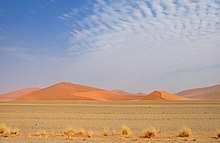
Namibia is a land of astounding natural beauty. To truly appreciate the country, you need to get out in the countryside, either on a tour or by renting a car, and take in the deserts, the mountains, the villages and everything else that Namibia has to offer.
One of its most dominant features, and the one for which the country is named, is the Namib Desert, which stretches for nearly 1000 km along the Atlantic coast. One of the oldest deserts in the world, its sand takes on a distinctive rust colour, with the desert having some of the highest sand dunes in the world. Sossusvlei is the most accessible part of the desert and is a magical place with its towering dunes that shift hues as the sun rises and sets. Further south, near the South African border, is Fish River Canyon, one of the largest canyons in the world. Stretching for 160 km, it is reaches 27 km across at its widest and nearly 550 m down at its deepest. In the north of the country is the empty and mostly inaccessible Skeleton Coast National Park. It is a seemingly barren expanse of stone and sand famous for its fog and the number of shipwrecks along the coast.
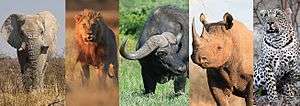
Namibia still has plenty of African wildlife to see and is one of the countries where all of the Big Five (lion, leopard, rhinoceros, elephant, buffalo) can be seen in the wild. There are also some local subspecies, such as desert lions, desert elephants and the Hartmann's mountain zebra, which are adapted to the harsh desert climate. Grazing animals like gemsbok, ostrich and springbok are also common. Namibia's national parks are an excellent starting point and one of the most famous is Etosha National Park in the north. The park surrounds the Etosha salt pan, which attracts animals, particularly in the drier winter months, because it is a source of water in a very dry land. Other notable spots to view wildlife are Waterberg Plateau Park, the parks of the Caprivi and the remote Kaokoland.
Namibia has a German influence from colonial times that is retained in some of its buildings. Windhoek has a number of interesting buildings like the Christuskirche, the train station and the castle-like Heinitzburg Hotel. Lüderitz is a colonial era town with distinctive German Imperial and Art Nouveau styles. Nearby is the abandoned mining town of Kolmanskop. Once a thriving center for diamonds, the miners moved on and the sand dunes have moved in, but tours are still available.
Do
- Go on safari. Explore landscape and wildlife by car. For many of the wild animals you do not need to visit a national park. Just leave the major highways, and you will bump into (not literally, hopefully) giraffe, ostrich, kudu, oryx, baboon, and much more.
- Go on a 4x4 tour. See our Off-roading in Namibia article.
- Explore ghost towns of the diamond rush around the coastal town of Lüderitz
- Fly with a hot-air balloon across the dunes at Sossusvlei
- Ride a sandboard or a quadbike through the dunes in the coastal area around Walvis Bay and Swakopmund
Buy
Money
|
Exchange rates for Namibian dollar As of 27 April 2019:
Exchange rates fluctuate. Current rates for these and other currencies are available from XE.com |
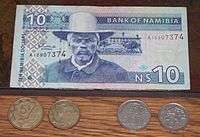
The currency of the country is the Namibian dollar, denoted by the symbol "$" or "N$" (ISO currency code: NAD). It is divided into 100 cents.
Namibia, Lesotho, South Africa and Eswatini (Swaziland) form the Southern African Common Monetary Area through which each country's currency is pegged 1:1 to the South African Rand (ZAR). Both the Namibian dollar and South African rand are legal tender in Namibia though change will usually be given in Namibian dollars.
Banks in Namibia will convert Namibian dollars for South African rand and vice versa without charge or paperwork. Since any bank or currency exchange outside Namibia (including other members of the Common Monetary Area) will charge a substantial service fee to change currency, it is advisable to make use of a Namibian Bank before leaving the country.
It is also advisable to carry proof (for example, ATM receipts) that money you are taking out of the country is money that you brought into the country in the first place.
Current official exchange rates are available from the Namibian Central Bank
Automated teller machines are available in all towns. "Town" in Namibia is defined as "being independently governed", and not by size. Some towns thus are really small. Most villages do not feature an ATM. Be also advised that not everything on the Namibian map is a settlement. "Red drum" in Kunene Region is just that, a red drum, and "Sossusvlei" is a clay pan, not a village. And has no ATM, of course. It is best to use only teller machines that are manned by a security guard in uniform. Always be careful to make sure no one is watching you enter your PIN, and be vigilant about typical scams (e.g. machines that seem to eat your card and won't give it back after you enter the PIN).
The cross-border money transfer facilities are limited and expensive, with one of the poorest currency buying-and-selling rates, because government does not want the money to be sent out of the country. There are only a few Western Union Money Transfer offices in Namibia.
Shopping
Prices in shops are fixed, but prices in open markets or from street vendors are open to bargain.
In most towns you will be approached by many locals to buy souvenirs, when this happens a 'no thanks' will usually suffice and they will leave you alone. It is common to haggle. Try to buy as much as possible from small shops instead of bigger ones—it's the best way to help the poor local population. Please do not buy high-quality ware like cell phones or safari gear from mobile vendors. They often trade in contraband, and obtaining such goods may get you into trouble.
Diamonds
Namibia is home to some of the most productive diamond mines in the world, and since all mines are owned by a government-de Beers partnership, prices in Namibia are generally quite lower than in the Western world, where monopolies control the prices. Most large towns in Namibia have stores that sell diamonds.
Possession of uncut diamonds is illegal in Namibia and carries lengthy jail terms. Any attempt to sell them to you is likely a rip-off, anyway.
Eat
Namibians have a very high intake of meat, and a very low intake of vegetables. This has to do with the semi-arid climate; agriculture almost exclusively is cattle, sheep, and goat farming while edible plants only grow when irrigated. As a result, meat is good, cheap, and plentiful, while fruits and vegetables are neither.
A very popular way to eat and socialise is the braai, a mixed wood-fired barbecue with lots of alcoholic drinks. Every campsite, every lodge, and every domestic home has pre-installed braai facilities.
In the coastal towns seafood is fresh and inexpensive. Make sure you try the local specialities kingklip and sole. Hake is also available and cheap. Restaurants will often offer line fish or angel fish which is simply what the fishermen managed to haul out from the sea—do ask what kind of fish it is before ordering. Inlands, fish is also served in restaurants but how fresh it is is a matter of luck. Of course it has been frozen during the transport across the Namib Desert; if you don't like that then order something else.
All towns have supermarkets with all standard products, although most fruits and vegetables are imported and therefore rather expensive. Shops in villages will have very little fresh produce. Even if they have cold storage it will mostly be used for drinks. Far away from bigger towns tomatoes, onions, potatoes and apples is all you can hope for, and mostly not at once. Also buying meat can be a challenge unless you are prepared to take the whole animal. Travellers usually take along mobile fridges, or at least several coolboxes, to complement the restricted offer. Coolboxes are so ubiquitous that there is a local viral video about them.
Vegetarians can have a difficult time in Namibia. In restaurants the waiter will offer to bring a side salad in meal size, if you are lucky. With the exception of Windhoek, Swakopmund, and the really expensive lodges you won't find anything that is purposefully vegetarian. Some people will offer chicken because that is 'not meat'.
Drink
Namibia's nightclubs are always happening and always open late (pretty much until the last person leaves). They are only located in bigger cities. The local version of a bar is the shebeen, a formal or informal structure with a counter for alcohol sale, a TV, a slot machine, and often a pool table. Drinks in shebeens are very cheap, and there are a lot of them, but most are situated in the townships. The flagship beer of Namibia is Windhoek Lager, an easy-drinking filtered beer, brewed by resident German master brewers.
The sale of alcohol for take-away is not allowed between Saturday 13:00 and Monday morning; all holidays count as Sundays. That means in supermarkets, which usually are open every day, the fridges with alcoholic drinks will be padlocked during this period. In informal areas (townships, shebeens, or remote villages) this rule is seldom enforced.
Sleep
Camping
Namibians love camping and the outdoors. Near every tourist attraction you will find several camp sites, from very simple, communally run places on sand that just have water and a dry toilet (about 100 N$ per person) to private park-like settings with lush grass, power sockets and a sink per camping spot, shade, and private WCs (about 200 N$ per person). In the national parks there are places without any amenities where you even have to bring water. These often need a 4x4 to get to, and you have to buy a permit in advance which is more expensive than staying at the best camp sites in the country. The chance to get caught without a permit is small but if they get you they will impose a 7.800 N$ fine—per person! If you spot a nice place to camp next to the road, check if there is a fence. If there's a fence then that's a farm. Farms are private properties. Don't enter a farm without notifying the farmer and asking for permission. Wild camping is allowed (but not very safe, luxurious or pleasant) on the side of the road between the banks and the farm fence, or in the areas that are neither commercial farms nor protected areas.
Backpackers
There are a few dormitories and hostels, but only in the older and larger towns. Neither hitchhiking nor backpacking are very common among tourists.
Lodges
Every tourism establishment that thinks it offers quality will call itself a lodge. It means that besides a roof over your head there are additional offerings like a restaurant, a pool, game drives, sports activities, hunting, and more. Originally far away from urban centres, even ordinary B&Bs will have the name 'lodge' today.
- The traditional lodges are for tourists with deep pockets. Their prices typically include all meals, a game drive, sundowner excursion with drinks, entertainment by local cultural groups, and so on. Many offer supreme privacy and luxury. These lodges, see Serra Cafema for an example, will tell their rates only upon request and charge anything between 3,000 N$ and 15,000 N$ pppn—The more inaccessible the higher the price, with the most expensive places those to which there is not even a 4x4 track, and a fly-in the only option.
- The new lodges are those accommodation establishments that want to offer more than a bed and a breakfast. While indeed a bit more expensive than a B&B, many are worth visiting and do return value. Expect to pay between 800 N$ and 2,500 N$ pppn, activities not included. For an example, see Okambara Elephant Lodge or Erindi Old Traders' Lodge.
As a rule, if a lodge also offers a campsite, it is not ridiculously expensive. Apparently the wealthy do not like to mingle too much with dusty people pitching tents.
Work
It is extremely difficult for foreigners to get work permits in Namibia. With about 35% unemployment, the government is not enthusiastic about letting people in who would take jobs from Namibians. All semi-skilled and unskilled positions must be unconditionally filled by local Namibians. It is possible to get a work permit to volunteer, though this requires going through the same drawn out process as the normal work permit.
An employee's salary is normally paid in Namibian dollars and income tax (maximum rate is 37% and is based on different income slabs) is deducted by the employer. The capital city of Windhoek is one of the least expensive places in the world for expatriates to live.
Stay safe
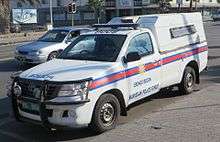
Namibia is a peaceful country and is not involved in any wars. Since the end of the Angolan civil war in May 2002, the violence that spilled over into northeastern Namibia is no longer an issue. Namibia is, however, a country with extreme income disparities. A middle manager easily earns twenty times the salary of a cleaner, and a third of the workforce is unemployed. As a tourist you're inevitably seen as stinking rich, and a prime target for thieves.
Namibia has a relatively high crime rate, particularly sexual abuse, general violence after alcohol abuse, and theft. Be careful on or right after pay day, the last day of the month, when there will be more drunk people than anyway usual. Travellers should have no problem visiting the townships, but do not go there on your own, or after dark. In Windhoek you can book township tours where you will be taken to the most interesting places, but that's not the same as going there yourself and see that there are people living there like you and me.
For foreigners, it is not prudent to walk or ride taxis alone after sunset. Pickpockets can be a problem. No local will carry a bag while walking, and for thieves the bag is the token to make out who is a tourist and who isn't. Stuff all possessions into your trousers' pockets. If you rent a car, insist that the owner (rental company) of the car is clearly visible with stickers or as car paint. In the event of carjacking there is no easier way to relax the attitude of the robbers than pointing out that the car isn't yours. Besides, as pretty much all rented cars have hidden communication devices, no carjacker in his right mind will take one from a rental company.
Most reported robberies take place just outside of the city centre. The police report that taxi drivers are often involved: they spot vulnerable tourists and coordinate by cell phoning. Take these warnings in context; if you are alert and take some common sense precautions, you should have no problems. Never be specific when asked where you stay; "in town" or "at some B&B" is sufficient for all good-faith conversations and doesn't disclose your intended route.
Namibia has a serious problem with driving under the influence of alcohol. The problem is aggravated because most people consider it no problem. When driving or walking on weekend evenings, be especially alert. Pedestrians have no rights anywhere in Africa. The person in a car (the more expensive the better) is more important, and has the right of way. This specifically includes zebra crossings and green pedestrian traffic lights—even expats and fellow tourists will not stop for someone on foot in order not to confuse local drivers.
Prostitution is legal but soliciting is not, that's why there are no brothels. Bars that are frequented by tourists will attract hookers at night. It is not a good idea to pick one from the street because those are the ones that have been banned from the bars, for whatever reason.
Stay healthy
The HIV infection rate in Namibia is around 17%, which is lower than before but is still the leading cause of death in the country.
Namibia's medical system is modern and capable of attending to whatever needs you may have. Staff are well trained and so HIV transmission in hospitals is not an issue. This applies to government and private hospitals alike, though line-ups are often shorter at private hospitals, and there have been cases of incorrect diagnosis in government hospitals. Should you become a victim of violence, private doctors and hospitals will send you away. The reason is that staff treating you will be summoned as witnesses to subsequent court cases without compensation, and lose valuable working time. In state hospitals, where productivity is not an issue, you will be treated at almost no charge. Thereafter do consult a private practice to confirm diagnosis and treatment. All private medical facilities expect cash or credit card in advance, no matter if or where you are insured. A visit to the doctor will be about 500 N$, for a night in hospital you'll have to deposit at least 10,000 N$.
The northern part of Namibia is in a malaria-risk zone, so consult a doctor before leaving, and take appropriate malaria precautions when travelling in these areas.
Ensure you are well stocked with water when journeying through the hot and sparsely populated country. On main roads take along at least 2 liters of potable water per person. In lesser travelled areas, 5 litres per person are the absolute minimum. If your car breaks down it can take days (!) for someone else to pass through. Namibia's water supply is usually safe to drink, except where labelled otherwise. Campsites next to rivers often get their water directly from the river. This water is clean but still disturbs some stomachs. Windhoek has the oldest direct water reclamation plant in the world. "Direct" means toilet-to-tap in one go, and many Windhoekers are uncomfortable with that and only drink bottled water. However, the water is completely safe, it just doesn't taste very good.
Having said all this, make sure you consult a physician specializing in health issues of Southern Africa, as well as things like the Centre for Disease Control web page. Make sure you satisfy yourself of the safety of anything you're getting into.
Respect
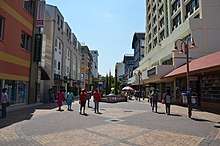
Namibians are very proud of their nation. It is a well developed country (albeit still economically developing) with all the modern amenities and technologies. Namibians have been exposed to a surprisingly wide variety of peoples during the United Nations supervising of the elections, as well as from various volunteer organizations. As in many African countries, the further away you come from the more curiosity you are going to attract.
It is customary when greeting someone to ask them how they're doing. It's a simple exchange where each person asks "How are you?" (or the informal version "Howzit?"—"Sharp, bro") and responds with a correspondingly short answer "Good, yourself?", and then proceed with whatever your business is about. It's a good idea to say this at tourist info booths, in markets, when getting into taxis and even in shops in Windhoek (though it's normally not said in some of the bigger stores in the malls).
Dress
Shorts and pants are worn by Namibians, so no one is offended if tourists dress in that style, too. Generally a dress that is overly safari-like is only appropriate if you are indeed on safari. Everywhere else it will earn you anything from mild smiles to outright laughter, not to mention that such attire screams "tourist". Black Namibians are sometimes dressed very formally, also outside working hours, while some white Namibians are the exact opposite. So on one hand you may see patrons in a shebeen donning dinner dress or black suit while on the other, managers or owners of fairly large businesses walking about with shorts and thick, knee-high socks, to prevent snakes from biting their lower legs, even in the capital where there are few snakes.
For festivities and church service everyone is dressed formally or traditionally. The traditional dresses of the women originate from the early colonial era and can look funny and out of place today. Don't laugh, culture is very important in Namibia.
Race
Race is a common part of Namibian discourse. That is to say, Namibians will refer to the race of others more frequently than travellers from places where race is typically not an issue, would expect. Because of apartheid, race is an issue in many spheres of life, so it comes up a lot. In spite of this, the various races do get along well in Namibia, and it is fairly uncommon to find racial tensions flaring. Even the various past conflicts were about cattle and land, not race.
Those who are more accustomed to North American racial terminology should understand that words that are familiar to them have different meanings in Namibia and South Africa, and the rules for what terms are polite or not are different. If in doubt, call them 'Namibians'.
- Coloured is a term for people of mixed ancestry, those with a skin colour between white and black. Don't call a black person 'coloured' in Namibia, as it implies 'Your ancestors slept with the Whites'.
- Baster (bastard) is the term for the coloured people at Rehoboth. They are proud to be Basters, but don't call anyone else (particularly other coloureds) that way.
- Black are Namibians of solely, or mostly, African ancestry—those with dark skin. It is not considered derogatory; most African people in Namibia are proud to be black.
- White are the descendents of various European immigrants. Some have lived in Africa for centuries, others recently entered. While it is generally not problematic to call someone 'white', there is a certain undertone of 'You do not belong here'.
- There is now also a sizeable Chinese community in Namibia, about 2% of the population. Namibians normally refer to anyone visibly Asian as "Chinese". If you are Japanese, Korean, Kazakh, Vietnamese, or any of the other myriad Asian ethnicities which are not Chinese, you may try to explain your situation; however, your three weeks of holidays will likely not be sufficient time to convince most Namibians to drop the habit.
Gay and lesbian travellers
Namibians have an ambivalent attitude towards gays and lesbians. Sexual intercourse between men is illegal, and there are no laws supporting LGBT rights. In the early 2000s there were a few incidents of discrimination, harassment and violence, along the statement that homosexuality is "un-African". The current situation is more like "leave them alone". The so-called Sodomy Law has never been enforced. As not many Namibians discuss sexuality with strangers, outing yourself for no apparent reason will be perceived as odd. When booking a room together it may be wise not to disclose that you are married.
On the other hand, homosexuality is really common, and in many bars you'll find same-sex couples. Showing affection in public is generally rare and happens only in bars and nightclubs when people are drunk. Everywhere else it is expected that it happens in private, even more so for same-sex couples.
Connect
By phone
Namibia's country code is 264. Each city or region has a two-digit area code. When calling long distance within Namibia, prefix the area code with a '0'. There are still a few pay phone booths around the country but they are no longer maintained. When making an international call from a phone booth, bring plenty of coins. Such calls are still expensive in Namibia, and it requires some dexterity to stuff coins in fast enough to not be cut off.
By GSM
Mobile phones are very common and run on the GSM network, using the same frequency as Europe and the rest of Africa. There are two cell phone providers in Namibia, MTC and Telecom. Coverage is complete in all towns and on the major highways. On minor roads and in the country side you won't have reception, despite both providers advertising near-complete coverage. All major tourist destinations are covered by MTC. Telecom has better coverage in villages that are not on tourist routes, and is more practical near the borders. For instance, at the Orange River MTC SIM cards will connect to a South African tower and charge international rates, while Telecom has no roaming agreements and will connect you to towers on the Namibian side.
A new SIM card costs N$10 or less and has N$5 of credit on it. Unlike in South Africa you don't need a passport to register them (February 2018) but the legislation to make this compulsory is coming soon. Bundles are available at N$30-50N, valid for a week, and give several hundred SMSs, 100 call minutes or more, and 1-2GiB of data. These bulk options, called "Away" for MTC and "Jiva" for Telecom, are very common. MTC SIM cards need to be activated by phoning or texting to them. Data usage needs to be activated in an official outlet of the provider, only available in larger towns. Recharge vouchers are available everywhere for MTC. Only few vendors stock Telecom vouchers, buy them in advance with the SIM card. When recharging, 15% tax is deducted; a N$30 voucher will give you N$26.09 credit, not N$30.
By Wi-Fi
The Internet cafes in all major towns are dying because virtually every restaurant, bar, B&B and camp site has free Wi-Fi. On the International Airport you have to pay for it.
Voice over IP
Voice over IP is illegal in Namibia. Private persons will not be prosecuted for it but you will not find shops offering cheap international calls, and you will not be allowed to Skype from an Internet Cafe.
Go next
The bordering nations of South Africa, Botswana and Angola are three obvious places to consider going next.
